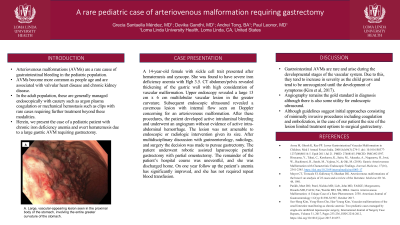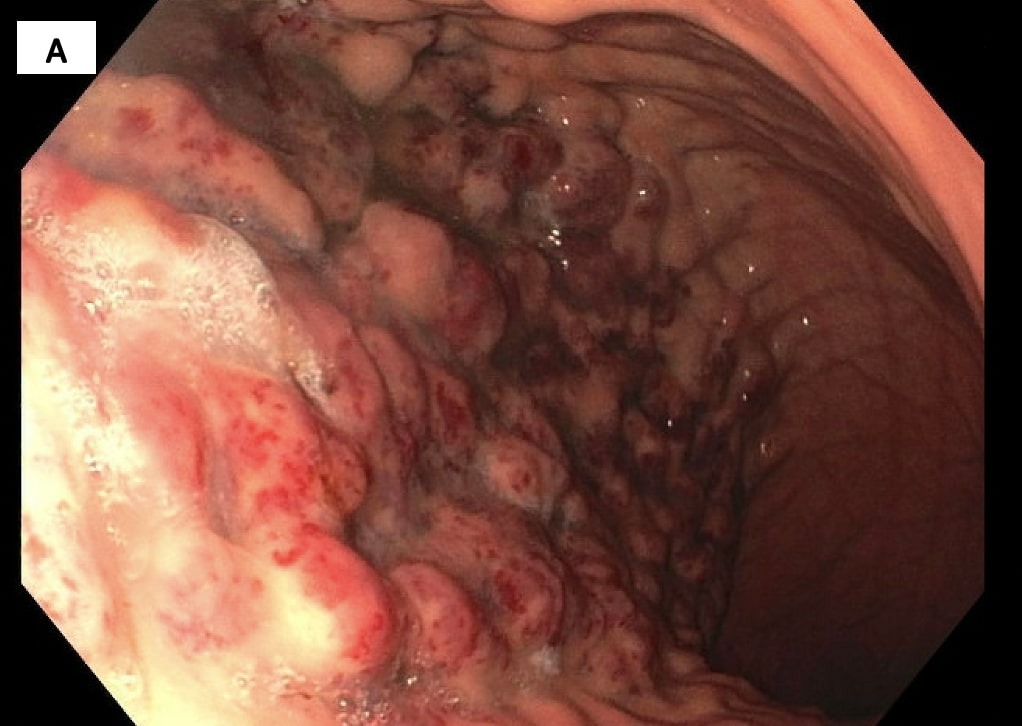Sunday Poster Session
Category: Stomach
P1398 - A Rare Pediatric Case of Arteriovenous Malformation Requiring Gastrectomy
Sunday, October 22, 2023
3:30 PM - 7:00 PM PT
Location: Exhibit Hall

Has Audio

Grecia Santaella Mendez, MD
Loma Linda University Health
Loma Linda, CA
Presenting Author(s)
Grecia Santaella Mendez, MD1, Devika Gandhi, MD2, Andrei Tong, BA2, Paul Leonor, MD2
1Loma Linda University Health, Loma Linda, CA; 2Loma Linda University, Loma Linda, CA
Introduction: Arteriovenous malformations (AVMs) are a rare cause of gastrointestinal bleeding in the pediatric population. AVMs become more common as people age and are associated with valvular heart disease and chronic kidney disease. In the adult population, these are generally managed endoscopically with cautery such as argon plasma coagulation or mechanical hemostasis such as clips with rare cases requiring further treatment beyond these modalities. Herein, we present the case of a pediatric patient with chronic iron deficiency anemia and overt hematemesis due to a large gastric AVM requiring gastrectomy.
Case Description/Methods: A 14 year old female with sickle cell trait presented after hematemesis and syncope. She was found to have severe iron deficiency anemia with Hgb 3.5. CT abdomen/pelvis revealed thickening of the gastric wall with high consideration of vascular malformation. Upper endoscopy revealed a large 13 cm x 6 cm multilobular vascular lesion in the greater curvature. Subsequent endoscopic ultrasound revealed a cavernous lesion with internal flow seen on Doppler concerning for an arteriovenous malformation. After these procedures, the patient developed active intraluminal bleeding and underwent an angiogram without evidence of active intra-abdominal hemorrhage. The lesion was not amenable to endoscopic or radiologic intervention given its size. After multidisciplinary discussion with gastroenterology, radiology, and surgery the decision was made to pursue gastrectomy. The patient underwent robotic assisted laparoscopic partial gastrectomy with partial omentectomy. The remainder of the patient’s hospital course was uneventful and she was discharged home. On one year follow up the patient’s anemia has significantly improved and she has not required repeat blood transfusion.
Discussion: Gastrointestinal AVMs are rare and arise during the developmental stages of the vascular system. Due to this, they tend to increase in severity as the child grows, and tend to be unrecognized until the development of symptoms (Kim et al, 2017). Angiography remains the gold standard in diagnosis although there is also some utility for endoscopic ultrasound. Although guidelines suggest initial approaches consisting of minimally invasive procedures including coagulation and embolization, in the case of our patient the size of the lesion limited treatment options to surgical gastrectomy.

Disclosures:
Grecia Santaella Mendez, MD1, Devika Gandhi, MD2, Andrei Tong, BA2, Paul Leonor, MD2. P1398 - A Rare Pediatric Case of Arteriovenous Malformation Requiring Gastrectomy, ACG 2023 Annual Scientific Meeting Abstracts. Vancouver, BC, Canada: American College of Gastroenterology.
1Loma Linda University Health, Loma Linda, CA; 2Loma Linda University, Loma Linda, CA
Introduction: Arteriovenous malformations (AVMs) are a rare cause of gastrointestinal bleeding in the pediatric population. AVMs become more common as people age and are associated with valvular heart disease and chronic kidney disease. In the adult population, these are generally managed endoscopically with cautery such as argon plasma coagulation or mechanical hemostasis such as clips with rare cases requiring further treatment beyond these modalities. Herein, we present the case of a pediatric patient with chronic iron deficiency anemia and overt hematemesis due to a large gastric AVM requiring gastrectomy.
Case Description/Methods: A 14 year old female with sickle cell trait presented after hematemesis and syncope. She was found to have severe iron deficiency anemia with Hgb 3.5. CT abdomen/pelvis revealed thickening of the gastric wall with high consideration of vascular malformation. Upper endoscopy revealed a large 13 cm x 6 cm multilobular vascular lesion in the greater curvature. Subsequent endoscopic ultrasound revealed a cavernous lesion with internal flow seen on Doppler concerning for an arteriovenous malformation. After these procedures, the patient developed active intraluminal bleeding and underwent an angiogram without evidence of active intra-abdominal hemorrhage. The lesion was not amenable to endoscopic or radiologic intervention given its size. After multidisciplinary discussion with gastroenterology, radiology, and surgery the decision was made to pursue gastrectomy. The patient underwent robotic assisted laparoscopic partial gastrectomy with partial omentectomy. The remainder of the patient’s hospital course was uneventful and she was discharged home. On one year follow up the patient’s anemia has significantly improved and she has not required repeat blood transfusion.
Discussion: Gastrointestinal AVMs are rare and arise during the developmental stages of the vascular system. Due to this, they tend to increase in severity as the child grows, and tend to be unrecognized until the development of symptoms (Kim et al, 2017). Angiography remains the gold standard in diagnosis although there is also some utility for endoscopic ultrasound. Although guidelines suggest initial approaches consisting of minimally invasive procedures including coagulation and embolization, in the case of our patient the size of the lesion limited treatment options to surgical gastrectomy.

Figure: A. Large, vascular-appearing lesion seen in the proximal body of the stomach, involving the entire greater curvature of the stomach.
Disclosures:
Grecia Santaella Mendez indicated no relevant financial relationships.
Devika Gandhi indicated no relevant financial relationships.
Andrei Tong indicated no relevant financial relationships.
Paul Leonor indicated no relevant financial relationships.
Grecia Santaella Mendez, MD1, Devika Gandhi, MD2, Andrei Tong, BA2, Paul Leonor, MD2. P1398 - A Rare Pediatric Case of Arteriovenous Malformation Requiring Gastrectomy, ACG 2023 Annual Scientific Meeting Abstracts. Vancouver, BC, Canada: American College of Gastroenterology.
